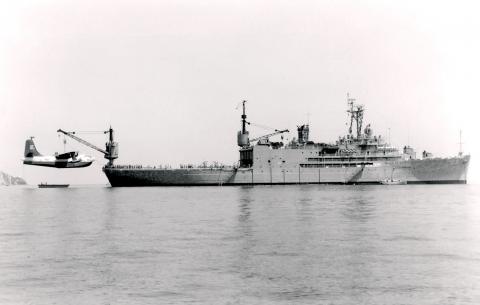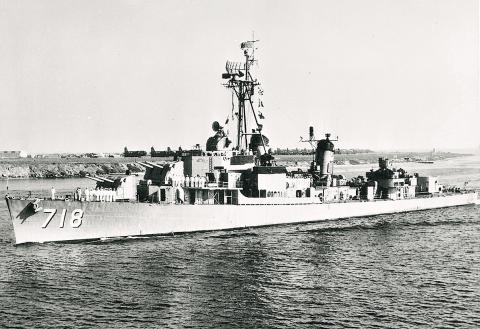Taiwan in Time: Jan. 25 to Jan. 31
All had been calm on the Taiwan Strait for about three years since the Taiwan Patrol Force, formed by destroyers from the US Navy’s Seventh Fleet, entered the strait in 1950 to prevent both sides from attacking each other.

Photo courtesy of Wikimedia Commons
It wasn’t easy patrolling the strait due to rough seas and unstable, harsh weather which often brought strong winds, monsoons and typhoons. The geography of the strait would often exacerbate the storms hitting the destroyers sailing up and down the narrow body of water.
“Since the primary goal was to deter invasion from either side, the patrols often had the appearance of steaming up and down aimlessly,” Bruce Elleman writes in the book High Seas Buffer. “However, success was measured by what did not happen — no news was good news.”
This passage symbolized the US’ position toward the cross-strait conflict between the Chinese Nationalist Party (KMT) and the Chinese Communist Party (CCP), which had just parted ways in 1949 after the Chinese Civil War.

Photo courtesy of Wikimedia Commons
But the no-news period didn’t last long. Hostilities resumed on several islands off China’s coast in 1953 after the lifting of the blockade, leading to the KMT losing two islands, the signing of the Sino-American Mutual Defense Treaty in December and passing of the Formosa Resolution on Jan. 29, 1955, setting the tone of events in decades to come.
Prior to the Korean War in 1950, US President Harry S. Truman had maintained that his country would stay out of any KMT-CCP disputes. But he changed his mind later and decided on the “neutralization of the Taiwan Strait,” not only because of the US’ anti-communist policy but also because of Taiwan’s strategic location in the supply line for US troops in Korea.
“In these circumstances the occupation of Formosa by Communist forces would be a direct threat to the security of the Pacific area and to United States forces performing their lawful and necessary functions in that area. Accordingly, I have ordered the 7th Fleet to prevent any attack on Formosa,” he declared.
Elleman writes that it also carried the purpose of preventing the KMT from any armed activity against China.
As a result, an anticipated invasion of Taiwan never happened, even though the patrol was mostly symbolic and carried little military value.
“Two (destroyer escorts) with two three-inch guns apiece did not constitute much of a military presence, but as a symbol of commitment the patrol definitely had value,” James Barber, a former patrol force member, says.
This naval blockade was lifted in February 1953 near the conclusion of the Korean War, when new president Dwight Eisenhower responded to calls from right-wing politicians to “unleash [KMT leader] Chiang Kai-shek (蔣介石)” on the Chinese communists. Cold war historian Haruka Matsumoto writes in a study that Chiang was “rejuvenated” by the decision and began making concrete plans to retake China.
The KMT launched a failed invasion of one of China’s offshore islands it previously held and later moved large numbers of soldiers to the offshore islands of Kinmen and Matsu while the People’s Republic of China amassed troops of its own. This led to the First Taiwan Strait Crisis, when then-Chinese premier Zhou Enlai (周恩來) called for the liberation of Taiwan in August 1954 and the People’s Liberation Army began bombing Kinmen a month later despite US warnings.
In December, the KMT and the US agreed to the Mutual Defense Treaty, in which only Taiwan and Penghu were mentioned, not the offshore islands. The US’ goal for the treaty, Matsumoto writes, was to prevent any attack from both sides of the Taiwan Strait so it wouldn’t have to directly fight China or possibly the Soviet Union.
Fighting intensified as the communists took Yijiangshan Island (一江山) on Jan. 18, 1955, and launched an attack on Dachen Island (大陳) the next day. The US, having promised to defend Taiwan and Penghu, reportedly saw these offshore islands as of little strategic value and not worth triggering a war with China. It eventually convinced a reluctant Chiang to evacuate the islands, and passed the Formosa Resolution on Jan. 29, which authorized Eisenhower to use force for the “specific purpose of securing and protecting Formosa and the Pescadores against armed attack” as well as “related positions and territories of that area now under friendly hands.”
Like the patrol, Matsumoto writes that this act was meant to intimidate the communists into inaction by officially signifying the US’s willingness to use force.
The patrol and the USS Midway helped with the evacuation of Dachen, which was completed on Feb. 12.
The US further tried to convince Chiang to abandon the remaining islands of Kinmen and Matsu in exchange for extra reinforcements in Taiwan, but Chiang refused. However, with the Soviet Union appearing unwilling to help the CCP in their cause, and Eisenhower making thinly-veiled nuclear threats, the communists stated on April that year that they were willing to negotiate the status of Taiwan, stopping all hostilities on May 1.
Peace would only last for three years, as violence flared up again three years later in the second Taiwan Strait crisis.
Taiwan in Time, a column about Taiwan’s history that is published every Sunday, spotlights important or interesting events around the nation that have anniversaries this week.

On April 26, The Lancet published a letter from two doctors at Taichung-based China Medical University Hospital (CMUH) warning that “Taiwan’s Health Care System is on the Brink of Collapse.” The authors said that “Years of policy inaction and mismanagement of resources have led to the National Health Insurance system operating under unsustainable conditions.” The pushback was immediate. Errors in the paper were quickly identified and publicized, to discredit the authors (the hospital apologized). CNA reported that CMUH said the letter described Taiwan in 2021 as having 62 nurses per 10,000 people, when the correct number was 78 nurses per 10,000

As we live longer, our risk of cognitive impairment is increasing. How can we delay the onset of symptoms? Do we have to give up every indulgence or can small changes make a difference? We asked neurologists for tips on how to keep our brains healthy for life. TAKE CARE OF YOUR HEALTH “All of the sensible things that apply to bodily health apply to brain health,” says Suzanne O’Sullivan, a consultant in neurology at the National Hospital for Neurology and Neurosurgery in London, and the author of The Age of Diagnosis. “When you’re 20, you can get away with absolute

May 5 to May 11 What started out as friction between Taiwanese students at Taichung First High School and a Japanese head cook escalated dramatically over the first two weeks of May 1927. It began on April 30 when the cook’s wife knew that lotus starch used in that night’s dinner had rat feces in it, but failed to inform staff until the meal was already prepared. The students believed that her silence was intentional, and filed a complaint. The school’s Japanese administrators sided with the cook’s family, dismissing the students as troublemakers and clamping down on their freedoms — with

As Donald Trump’s executive order in March led to the shuttering of Voice of America (VOA) — the global broadcaster whose roots date back to the fight against Nazi propaganda — he quickly attracted support from figures not used to aligning themselves with any US administration. Trump had ordered the US Agency for Global Media, the federal agency that funds VOA and other groups promoting independent journalism overseas, to be “eliminated to the maximum extent consistent with applicable law.” The decision suddenly halted programming in 49 languages to more than 425 million people. In Moscow, Margarita Simonyan, the hardline editor-in-chief of the